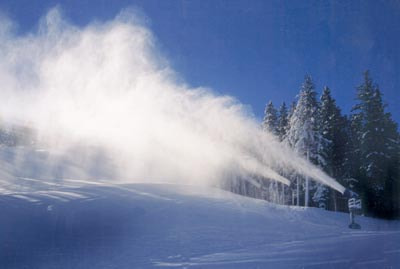
IELTS Practice Tests Plus Volume 2
- 发布时间: 15 Dec 2017
- 模考人次: 294,891
正确答案:
Part 1: Question 1 - 13
- 1 ix
- 2 iii
- 3 viii
- 4 i
- 5 vi
- 6 compressed
- 7 (tiny) droplets
- 8 ice crystals
- 9 depth
- 10 temperature and humidity
- 11 energy
- 12 insulation
- 13 aircraft
- 1 ix
- 2 iii
- 3 viii
- 4 i
- 5 vi
- 6 compressed
- 7 (tiny) droplets
- 8 ice crystals
- 9 depth
- 10 temperature and humidity
- 11 energy
- 12 insulation
- 13 aircraft
Part 2: Question 14 - 26
- 14 C
- 15 A
- 16 F
- 17 B
- 18 E
- 19 NOT GIVEN
- 20 TRUE
- 21 TRUE
- 22 NOT GIVEN
- 23 FALSE
- 24 C
- 25 B
- 26 D
- 14 C
- 15 A
- 16 F
- 17 B
- 18 E
- 19 NOT GIVEN
- 20 TRUE
- 21 TRUE
- 22 NOT GIVEN
- 23 FALSE
- 24 C
- 25 B
- 26 D
Part 3: Question 27 - 40
- 27 E
- 28 G
- 29 D
- 30 H
- 31 A
- 32 C
- 33 YES
- 34 NOT GIVEN
- 35 NO
- 36 NOT GIVEN
- 37 YES
- 38 E
- 39 F
- 40 C
- 27 E
- 28 G
- 29 D
- 30 H
- 31 A
- 32 C
- 33 YES
- 34 NOT GIVEN
- 35 NO
- 36 NOT GIVEN
- 37 YES
- 38 E
- 39 F
- 40 C
详细试卷答案解析:
Questions 1-5
Reading Passage 1 has seven paragraphs A-G.
Choose the correct heading for each paragraph from the list of headings below.
Write the correct number (i-x) in boxes 1-5 on your answer sheet.
| List of Headings | |
| i | Considering ecological costs |
| ii | Modifications to the design of the snow gun |
| iii | The need for different varieties of snow |
| iv | Local concern over environmental issues |
| v | A problem and a solution |
| vi | Applications beyond the ski slopes |
| vii | Converting wet snow to dry snow |
| viii | New method for calculating modifications |
| ix | Artificial process, natural product |
| x | Snow formation in nature |
Example | Answer |
Paragraph A | v |
Paragraph B | x |
Paragraph C | 1 |
Paragraph D | 2 |
Paragraph E | 3 |
Paragraph F | 4 |
Paragraph G | 5 |
- 1 Answer: ix
Keywords in Questions
Similar words in Passage
Q1:Artificial process, natural product
The snow gun works very differently from a natural weather system, but it accomplishes exactly the same thing. The device basically works by combining water and air. Two different hoses are attached to the gun. one leading from a water pumping station which pumps water up from a lake or reservoir,and the other leading from an air compressor. When the compressed air passes through the hose into the gun. it atomises the water - that is, it disrupts the stream so that the water splits up into tiny droplets. The droplets are then blown out of the gun and if the outside temperature is below 0°C, ice crystals will form, and will then make snowflakes in the same way as natural snow.
Note:
In Paragraph C,the writer describes how snow gun works and its natural end product.Therefore,the answer is ix.
- 2 Answer: iii
Keywords in Questions
Similar words in Passage
Q2: The need for different varieties of snow
Snow-makers often talk about dry snow and wet snow. Dry snow has a relatively low amount of water, so it is very light and powdery. This type of snow is excellent for skiing because skis glide over it easily without getting stuck in wet slush. One of the advantages of using a snow-maker is that this powdery snow can be produced to give the ski slopes a level surface. However, on slopes which receive heavy use, resort owners also use denser, wet snow underneath the dry snow. Many resorts build up the snow depth this way once or twice a year, and then regularly coat the trails with a layer of dry snow throughout the winter.
Note:In this paragraph,the writer mentions dry snow and wet snow and how they are used in different situations.Therefore,the answer is iii.
- 3 Answer: viii
Keywords in Questions
Similar words in Passage
Q3: New method for calculating modifications
The wetness of snow is dependent on the temperature and humidity outside, as well as the size of the water droplets launched by the gun. Snow-makers have to adjust the proportions of water and air in their snow guns to get the perfect snow consistency for the outdoor weather conditions. Many ski slopes now do this with a central computer system that is connected to weather-reading stations all over the slope.
Note:
In this paragraph,the writer mentions the factors that affect the wetness of snow and the need of calculating the proportions of water and air to get the perfect snow consistency for the outdoor weather conditions.Hence,the answer is viii. The heading ii is temting but it is wrong because this paragraph doesn’t mention anything about the design of the snow gun.
- 4 Answer: i
Keywords in Questions
Similar words in Passage
Q4: Considering ecological costs
But man-made snow makes heavy demands on the environment. It takes about 275,000 litres of water to create a blanket of snow covering a 60x60 metre area. Most resorts pump water from one or more reservoirs located in low-lying areas. The run-off water from the slopes feeds back into these reservoirs, so the resort can actually use the same water over and over again. However, considerable amounts of energy are needed to run the large air-compressing pumps, and the diesel engines which run them also cause air pollution.
Note:
In this paragraph,the author indicates the environmental cost when using man-made snow.These costs are mentioned in the paragraph such as air pollution .Therefore,the answer should be i
- 5 Answer: vi
Keywords in Questions
Similar words in Passage
Q5: Applications beyond the ski slopes
Because of the expense of making snow, ski resorts have to balance the cost of running the machines with the benefits of extending the ski season, making sure they only make snow when it is really needed and when it will bring the maximum amount of profit in return for the investment. But man-made snow has a number of other uses as well. A layer of snow keeps a lot of the Earth’s heat from escaping into the atmosphere, so farmers often use man-made snow to provide insulation for winter crops. Snow-making machines have played a big part in many movie productions. Movie producers often take several months to shoot scenes that cover just a few days. If the movie takes place in a snowy setting, the set decorators have to get the right amount of snow for each day of shooting either by adding man-made snow or melting natural snow. And another important application of man-made snow is its use in the tests that aircraft must undergo in order to ensure that they can function safely in extreme conditions.
Note:
In this paragraph,the writer indicates lots of ways to use man-made snow besides the ski slopes such as providing insulation for winter crops,movie productions,…..Therefore,the answer should be vi.
Questions 6-8
Label the diagram below using NO MORE THAN TWO WORDS from the passage for each answer.

6
7
8
- 6 Answer: compressed
Tip for diagram labelling task:
Passages which describe mechanical devices or processes may include a diagram labelling task.
1. Look at the diagram. What does it illustrate? How do you know?
2. Which paragraph in the passage explains how this device works? (Use the heading matching task to help you).
Read the paragraph carefully and study the diagram at the same time. Some labels are already given. Use these to help you.
3. On which side of the diagram does the process begin - left or right?
4. How many words can you write for each answer?
Be careful to copy the words you need accurately from the passage.
Q6-Q8:The picture is about the design of the snow gun.Therefore,we should find the paragraph that has information about the design of the snow gun.That is pargraph C
Keywords in Questions
Similar words in Passage
Q6 ____ air
When the compressed air passes through the hose into the gun
Note:
This blank must be fulfilled by an adjective which is related to air.It is mentioned in paragraph C : When the compressed air passes through the hose into the gun….Therefore,the answer is “compressed” because it is an adjective and it comes before “air”.
- 7 Answer: (tiny) droplets
Keywords in Questions
Similar words in Passage
Q7 water is atomised into___
it atomises the water - that is, it disrupts the stream so that the water splits up into tiny droplets.
Note:
The answer must be a noun as it follows the verb “is atomised into”.”atomise” means reducing (something) to atoms or other small distinct units so it is similar to “splits up”.Therefore,the answer is “tiny droplets”
- 8 Answer: ice crystals
Keywords in Questions
Similar words in Passage
Q8 ___are formed
ice crystals will form, and will then make snowflakes in the same way as natural snow.
The answer must be a noun as it comes before the verb “are formed”.In paragraph C ,the author writes “ice crystals will form…”.Therefore,the answer is “ice crystals”.
Questions 9-13
Complete the sentences below.
Choose NO MORE THAN THREE WORDS from the passage for each answer.
Write your answers in boxes 9-13 on your answer sheet.
Dry snow is used to give slopes a level surface, while wet snow is used to increase the 9 on busy slopes.
To calculate the required snow consistency, the 10 of the atmosphere must first be measured.
The machinery used in the process of making the snow consumes a lot of 11 which is damaging to the environment.
Artificial snow is used in agriculture as a type of 12 for plants in cold conditions.
Artificial snow may also be used in carrying out safety checks on 13
- 9 Answer: depth
Keywords in Questions
Similar words in Passage
Q9. Dry snow is used to give slopes a level surface, while wet snow is used to increase the___on busy lopes.
However, on slopes which receive heavy use, resort owners also use denser, wet snow underneath the dry snow. Many resorts build up the snow depth this way once or twice a year, and then regularly coat the trails with a layer of dry snow throughout the winter.
Note:
The answer must be a noun as it follows the verb “increase”.”dry snow”,”wet snow” are mentioned in paragraph D so the answer we are looking for is in that paragraph.The author indicates that wet snow is put under the dry snow to build up the snow depth:“on slopes which receive heavy use, resort owners also use denser, wet snow underneath the dry snow. Many resorts build up the snow depth this way…”.”slopes which receive heavy use” is equivalent to “busy lopes”,”increase” is similar to “build up” so the answer must be “depth”.
- 10 Answer: temperature and humidity
Keywords in Questions
Similar words in Passage
Q10. To calculate the required snow consistency, the___of the atmosphere must first be measured
The wetness of snow is dependent on the temperature and humidity outside, as well as the size of the water droplets launched by the gun. Snow-makers have to adjust the proportions of water and air in their snow guns to get the perfect snow consistency for the outdoor weather conditions.
Note:The answer we are looking for must be a noun.The snow consistency is mentioned in paragraph E so the answer is in that paragraph.The writer indicates that the wetness of snow or the snow consistency is dependent on two factors : the temperature and humidity outside,the size of the water droplets launched by the gun.”outside” is similar to “the atmosphere” so the answer is “temperature and humidity”.
- 11 Answer: energy
Keywords in Questions
Similar words in Passage
Q11. The machinery used in the process of making the snow consumes a lot of ___which is damaging to the environment
However, considerable amounts of energy are needed to run the large air-compressing pumps, and the diesel engines which run them also cause air pollution.
Note:
The answer must be a noun as it follows the word “a lot of”.The answer is in paragraph F as it mentions both environment and machines which are used to make the snow.”The machinery used in the process of making the snow” is equivalent to “large air-compressing pumps”,”air pollution”is similar to “damaging to the environment”,”considerable amounts of” is the same as “ a lot of “ so the answer is “energy”.
- 12 Answer: insulation
Keywords in Questions
Similar words in Passage
Q12. Artificial snow is used in agriculture as a type of ___for plants in cold conditions.
A layer of snow keeps a lot of the Earth’s heat from escaping into the atmosphere, so farmers often use man-made snow to provide insulation for winter crops.
Note:The answer must be a noun as it follows the word “ a type of “
In paragraph G,the author mentions artificial snow” or man-made snow’s applications besides ski slopes so the answer must be in this paragraph because the question is about how artificial snow is used in agriculture.”artificial snow” is similar to”man-made snow” and “plants”which is mentioned in paragraph G is “winter crops”.Therefore,the answer is “insulation”.
- 13 Answer: aircraft
Keywords in Questions
Similar words in Passage
Q13.Artificial snow may also be used in carrying out safety checks on___
And another important application of man-made snow is its use in the tests that aircraft must undergo in order to ensure that they can function safely in extreme conditions.
Note:The answer must be a noun as it follows the preposition “on”
In paragraph G,the author mentions artificial snow” or man-made snow’s applications besides ski slopes so the answer must be in this paragraph.The writer indicates that man-made snow is used to test air craft’s safe function in extreme conditions so the answer is “aircraft”
Reading Passage 1
You should spend about 20 minutes on Questions 1-13, which are based on Reading Passage 1 below.

Snow-makers
Skiing is big business nowadays. But what can ski resort owners do if the snow doesn't come?
A In the early to mid twentieth century, with the growing popularity of skiing, ski slopes became extremely profitable businesses. But ski resort owners were completely dependent on the weather: if it didn't snow, or didn’t snow enough, they had to close everything down. Fortunately, a device called the snow gun can now provide snow whenever it is needed. These days such machines are standard equipment in the vast majority of ski resorts around the world, making it possible for many resorts to stay open for months or more a year.
B Snow formed by natural weather systems comes from water vapour in the atmosphere. The water vapour condenses into droplets, forming clouds. If the temperature is sufficiently low, the water droplets freeze into tiny ice crystals. More water particles then condense onto the crystal and join with it to form a snowflake. As the snow flake grows heavier, it falls towards the Earth.
C The snow gun works very differently from a natural weather system, but it accomplishes exactly the same thing. The device basically works by combining water and air. Two different hoses are attached to the gun. one leading from a water pumping station which pumps water up from a lake or reservoir, and the other leading from an air compressor. When the compressed air passes through the hose into the gun. it atomises the water - that is, it disrupts the stream so that the water splits up into tiny droplets. The droplets are then blown out of the gun and if the outside temperature is below 0°C, ice crystals will form, and will then make snowflakes in the same way as natural snow.
D Snow-makers often talk about dry snow and wet snow. Dry snow has a relatively low amount of water, so it is very light and powdery. This type of snow is excellent for skiing because skis glide over it easily without getting stuck in wet slush. One of the advantages of using a snow-maker is that this powdery snow can be produced to give the ski slopes a level surface. However, on slopes which receive heavy use, resort owners also use denser, wet snow underneath the dry snow. Many resorts build up the snow depth this way once or twice a year, and then regularly coat the trails with a layer of dry snow throughout the winter.
E The wetness of snow is dependent on the temperature and humidity outside, as well as the size of the water droplets launched by the gun. Snow-makers have to adjust the proportions of water and air in their snow guns to get the perfect snow consistency for the outdoor weather conditions. Many ski slopes now do this with a central computer system that is connected to weather-reading stations all over the slope.
F But man-made snow makes heavy demands on the environment. It takes about 275,000 litres of water to create a blanket of snow covering a 60x60 metre area. Most resorts pump water from one or more reservoirs located in low-lying areas. The run-off water from the slopes feeds back into these reservoirs, so the resort can actually use the same water over and over again. However, considerable amounts of energy are needed to run the large air-compressing pumps, and the diesel engines which run them also cause air pollution.
G Because of the expense of making snow, ski resorts have to balance the cost of running the machines with the benefits of extending the ski season, making sure they only make snow when it is really needed and when it will bring the maximum amount of profit in return for the investment. But man-made snow has a number of other uses as well. A layer of snow keeps a lot of the Earth’s heat from escaping into the atmosphere, so farmers often use man-made snow to provide insulation for winter crops. Snow-making machines have played a big part in many movie productions. Movie producers often take several months to shoot scenes that cover just a few days. If the movie takes place in a snowy setting, the set decorators have to get the right amount of snow for each day of shooting either by adding man-made snow or melting natural snow. And another important application of man-made snow is its use in the tests that aircraft must undergo in order to ensure that they can function safely in extreme conditions.













